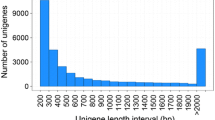Abstract
To explore the transcriptome of Musca domestica larvae and to identify unique sequences, we used massively parallel pyrosequencing on the Roche 454-FLX platform to generate a substantial EST dataset of this fly. As a result, we obtained a total of 249,555 ESTs with an average read length of 373 bp. These reads were assembled into 13,206 contigs and 20,556 singletons. Using BlastX searches of the Swissprot and Nr databases, we were able to identify 4,814 contigs and 8,166 singletons as unique sequences. Subsequently, the annotated sequences were subjected to GO analysis and the search results showed a majority of the query sequences were assignable to certain gene ontology terms. In addition, functional classification and pathway assignment were performed by KEGG and 2,164 unique sequences were mapped into 184 KEGG pathways in total. As the first attempt on large-scale RNA sequencing of M. domestica, this general picture of the transcriptome can establish a fundamental resource for further research on functional genomics.



Similar content being viewed by others
References
Malik A, Singh N, Satya S (2007) House fly (Musca domestica): a review of control strategies for a challenging pest. J Environ Sci Heal B 42(4):453–469
Izumi N, Yanagibori R, Shigeno S, Sajiki J (2008) Effects of bisphenol A on the development, growth, and sex ratio of the housefly Musca domestica. Environ Toxicol Chem 27(6):1343–1353
Krafsur ES, Moon RD, Kim Y, Rosales AL (1999) Dynamics of diapause recruitment in populations of the face fly, Musca autumnalis. Med Vet Entomol 13(4):337–348
Burghardt G, Hediger M, Siegenthaler C, Moser M, Dübendorfer A, Bopp D (2005) The transformer gene in Musca domestica is required for selecting and maintaining the female pathway of development. Dev Genes Evol 215(4):165–176
Bayne AC, Sohal RS (2002) Effects of superoxide dismutase/catalase mimetics on life span and oxidative stress resistance in the housefly, Musca domestica. Free Radic Biol Med 32(11):1229–1234
Lu XM, Jin XB, Zhu JY, Mei HF, Ma Y, Chu FJ, Wang Y, Li XB (2010) Expression of the antimicrobial peptide cecropin fused with human lysozyme in Escherichia coli. Appl Microbiol Biotechnol 87(6):2169–2176
Ren Q, Zhao X, Wang J (2009) Molecular characterization and expression analysis of a chicken-type lysozyme gene from housefly (Musca domestica). J Genet Genomics 36(1):7–16
Li DX, Kang CJ, Zhang W, Wang JX, Zhao XF (2010) Construction of a suppression subtractive hybridization cDNA library to identify differentially expressed genes from Musca domestica (Diptera: Muscidae) larvae. Acta Entomol Sin 53(6):601–610
Bouck A, Vision T (2007) The molecular ecologist’s guide to expressed sequence tags. Mol Ecol 16(5):907–924
Andersen JR, Lubberstedt T (2003) Functional markers in plants. Trends Plant Sci 8(11):554–560
Emrich SJ, Barbazuk WB, Li L, Schnable PS (2007) Gene discovery and annotation using LCM-454 transcriptome sequencing. Genome Res 17:69–73
Vera JC, Wheat CW, Fescemyer HW, Frilander MJ, Crawford DL, Hanski I, Marden JH (2008) Rapid transcriptome characterization for a nonmodel organism using 454 pyrosequencing. Mol Ecol 17(7):1636–1647
Barbazuk WB, Emrich SJ, Chen HD, Li L, Schnable PS (2007) SNP discovery via 454 transcriptome sequencing. Plant J 51(5):910–918
Novaes E, Drost DR, Farmerie WG, Pappas GJ Jr, Grattapaglia D, Sederoff RR, Kirst M (2008) High-throughput gene and SNP discovery in Eucalyptus grandis, an uncharacterized genome. BMC Genomics 9:312–325
Namroud MC, Beaulieu J, Juge N, Laroche J, Bousquet J (2008) Scanning the genome for gene single nucleotide polymorphisms involved in adaptive population differentiation in white spruce. Mol Ecol 17(16):3599–3613
Isler JA, Vesterqvist OE, Burczynski ME (2007) Analytical validation of genotyping assays in the biomarker laboratory. Pharmacogenomics 8:353–368
Zou Z, Najar F, Wang Y, Roe B, Jiang H (2008) Pyrosequence analysis of expressed sequence tags for Manduca sexta hemolymph proteins involved in immune responses. Insect Biochem Mol Biol 38(6):677–682
Kristiansson E, Asker N, Forlin L, Larsson DGJ (2009) Characterization of the Zoarces viviparus liver transcriptome using massively parallel pyrosequencing. BMC Genomics 10:345
Parchman TL, Geist KS, Grahnen JA, Benkman CW, Buerkle CA (2010) Transcriptome sequencing in an ecologically important tree species: assembly, annotation, and marker discovery. BMC Genomics 11:180–195
Wheat CW (2008) Rapidly developing functional genomics in ecological model systems via 454 transcriptome sequencing. Genetica 138(4):433–451
Codd V, Dolezel D, Stehlik J, Piccin A, Garner KJ, Racey SN, Straatman KR, Louis EJ, Costa R, Sauman I, Kyriacou CP, Rosato E (2007) Circadian rhythm gene regulation in the housefly Musca domestica. Genetics 177(3):1539–1551
Sackton TB, Lazzaro BP, Clark AG (2010) Genotype and gene expression associations with immune function in Drosophila. PLos Genet 6(1):e1000797
Hahn DA, Ragland GJ, Shoemaker DD, Denlinger DL (2009) Gene discovery using massively parallel pyrosequencing to develop ESTs for the flesh fly Sarcophaga crassipalpis. BMC Genomics 10:234–242
Kim T, Kim YJ (2005) Overview of innate immunity in Drosophila. J Biochem Mol Biol 38:121–127
Hoffmann JA (2003) The immune response of Drosophila. Nature 426:33–38
Kaneko T, Yano T, Aggarwal K, Lim JH, Ueda K, Oshima Y, Peach C, Erturk-Hasdemir D, Goldman WE, Oh BH, Kurata S, Silverman N (2006) PGRP-LC and PGRP-LE have essential yet distinct functions in the drosophila immune response to monomeric DAP-type peptidoglycan. Nat Immunol 7:715–723
Acknowledgments
This work was financially supported by the Specialized Research Fund for the Doctoral Program of Higher Education of China (No.20101301120005), the Natural Science Fund of Hebei Province (No. C2011201027), and the Natural Science Fund of Hebei University (No. 2010001).
Author information
Authors and Affiliations
Corresponding author
Additional information
F. Liu and T. Tang contributed equally to this work.
Rights and permissions
About this article
Cite this article
Liu, F., Tang, T., Sun, L. et al. Transcriptomic analysis of the housefly (Musca domestica) larva using massively parallel pyrosequencing. Mol Biol Rep 39, 1927–1934 (2012). https://doi.org/10.1007/s11033-011-0939-3
Received:
Accepted:
Published:
Issue Date:
DOI: https://doi.org/10.1007/s11033-011-0939-3




